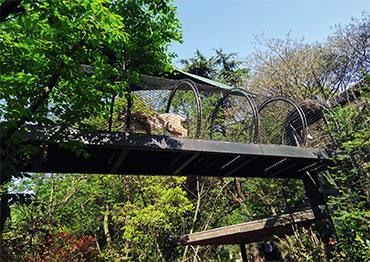The world’s oldest scientific zoo, London Zoo, opened in 1828. Over the next two centuries, many zoos around the world evolved from circus-like attractions to complex organizations that integrate entertainment, conservation, research and education.
There are more than 300 mid-sized and large zoos in China, accounting for a fifth of the world’s total. Every year, zoos in China see more than 100 million visitors. However, for most of the past three decades, Chinese zoos were outside the global zoological community.
The 2015 strategy document of the World Association of Zoos and Aquariums (WAZA) seeks to redefine the main priorities of zoos to include conservation and the promotion of animal welfare, but the majority in China are far from achieving this.
Animals are often kept in empty cages built on flat, concrete floors. Some zoos force them to perform shows. China has only one WAZA member – the Chimelong Safari Park in Guangzhou, Guangdong Province.
In late 2018, Hua Shi, a science writer with an interest in zoology, spent four months visiting 56 zoos in 41 cities in China and posting about them on social media. With 4.27 million followers on Sina Weibo, his critical reviews had an impact. In January 2021, the 32-year-old published his book Going to the Zoo is a Serious Matter, an exposé on the country’s zoos.
“A zoo is a place born of original sin, for it deprives animals of their freedom,” Hua told NewsChina. “They have to modernize in a real sense to repent.”
Taiyuan Zoo in Shanxi Province, which was closed for renovations until last October, was among the zoos Hua did not visit. The renovations cost a whopping 3 billion yuan (US$467m). The new zoo covers 1.34 square kilometers, double the area of the original.
Hua, who finally visited the zoo in March, was stunned by the massive size of the animal enclosures. The elephant house is the largest of all at 7,000 square meters. The exterior of its buildings borrow from designs found in European zoos. However, the interiors of the Taiyuan Zoo’s houses, as Hua put it, were “extremely terrible.”
The elephant house took its exterior design from Copenhagen Zoo in Denmark, even to the glass dome roof. But its interior was quite different.
“Elephants at Copenhagen Zoo walk on soft earth. There is yellow sand, mud ponds and water pools for the elephants to play in. The elephant habitat at the Taiyuan Zoo, however, has a flat, concrete floor. Inside the huge empty enclosure, there’s nothing but concrete pillars around the elephants. The environment there is so monotonous, making the habitat nothing more than a gigantic prison,” Hua told NewsChina.
Further vexing Hua are the animal shows at zoos, which in essence are circus performances. In 2013, Chinese authorities issued a guideline on zoo development that clearly bans animal shows. However, many still offer them, rebranded as “animal behavior exhibitions.”
In many ways, these malpractices pose underlying threats to animal conservation efforts in China.
An industry insider who insisted on anonymity told NewsChina that many zoos in China acquire large numbers of birds every year. But as their bird habitats usually lack adequate conditions for breeding, zoos rely on buying captured wild birds.
“It’s way cheaper to capture birds than buy birds from abroad. Many people catch birds in the wild and sell them to zoos,” said the insider.
This practice is even more prevalent with amphibians and reptiles, he said. In many Chinese zoos, management of amphibian and reptile houses is usually outsourced so zoos can distance themselves from any involvement in the wildlife trade.
Compared to other animal houses, feeding and facilities in amphibian and reptile houses are usually the worst. Every year, zoos buy animals caught in the wild to supplement their dwindling reserves.
“Amphibian and reptile houses at domestic zoos have done nothing for animal conservation.
Under many circumstances, to be frank, zoos are accomplices in destroying wildlife,” the industry insider told NewsChina.
A lack of zoological professionals has hampered the development of modern zoos in China.
From 1950 to 1970, major cities in China built parks, many of which included space for wildlife exhibitions. The late 1970s saw a sharp increase in privately run zoos. By 1983, China had 135 zoos.
Very few zoo managers have degrees in zoology or other related disciplines and spend more on landscaping and roads than animal welfare.
Zoos and wildlife parks in China are supervised by local parks and recreation authorities. As zoos are categorized as “special parks,” their construction and management are held to general park standards.
Moreover, professional zoo designers are scarce. China does not have an institute dedicated to zoo design. Most zoos in China today were designed by landscape architects. “They only know how to build beautiful parks,” Hua said.
The remodelling of Taiyuan Zoo was done by Shanghai Gardens Group, a landscape architecture firm. The zoo’s common green space, covering roughly 702,000 square meters, occupies more than half of the zoo’s total area.
Ma Ke is chief designer with the Chinese Association of Zoological Gardens (CAGZ) and the director of construction for Hongshan Forest Zoo in Nanjing, Jiangsu Province. From Ma’s perspective, the space utilization rate of domestic zoos is low compared with foreign zoos.
Zoos in China, Ma said, reserve more open space for tourists, while many foreign zoos use as much space for animal habitats as possible. “Sometimes they only leave relatively narrow walkways for tourists, and on either side of the walkways are vast playgrounds for animals,” Ma told NewsChina.
Ma stressed that due to the lack of mature design and management, most zoos are nothing more than entertainment venues where animals are housed in small and barren cages.
“We have to get to the root of the matter and correct these errors, otherwise the development of China’s zoos will remain completely chaotic in the coming decades,” the industry insider told NewsChina.

 Old Version
Old Version
